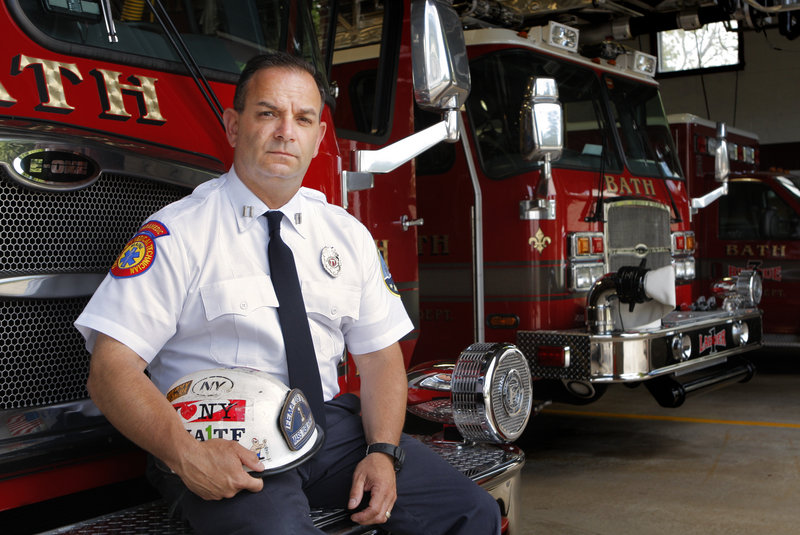BATH -There were no faces.
That’s what struck Bath firefighter Michael Clarke most as he scraped and cut his legs crawling through the rubble of the World Trade Center looking for survivors during the first eight days following the Sept. 11 attacks.
As they urgently searched under collapsed beams and inside dark voids, Clarke and other members of the FEMA Urban Search & Rescue Response team found credit cards, bits of clothing, a shoe with the foot still in it — but no survivors. And no faces.
Clarke, 48, is a fifth-generation firefighter who grew up on Long Island, N.Y. He was at a friend’s house in Bath when the two planes hit the World Trade Center. Clarke dropped his 8-year-old son off at the bus stop, then went home to pack in case he had to leave in a hurry for Beverly, Mass., where his FEMA team is based. Then came the phone call from his squad leader: “Tower 2 has a collapse, and we’re going.”
The team raced down the Massachusetts Turnpike toward New York in a convoy of 14 vehicles, with state police escorts, sailing through tollbooths and stopping for nothing. Along the way, Clarke wondered about his high school buddy, Billy Rooney, who was stationed at a fire company in Brooklyn. Was he safe?
And what about Paul Sarle, another old friend who was a broker at Cantor Fitzgerald in the North Tower? Sarle had been hailed as a hero during the bombing of the World Trade Center in 1993, when he carried a woman who had only one lung down 90 flights of stairs to safety.
Clarke had just seen these two friends, along with dozens of others — many of them firefighters or workers in the financial industry — at his 20th high school reunion. Now, as the convoy approached New York and he saw enormous clouds of smoke billowing above the skyline, he wondered how many were still alive.
The caravan arrived at the Jacob Javits Convention Center by late Tuesday afternoon, just after the 49 stories of Building No. 7 fell. That night, a reconnaissance team from Clarke’s task force went to the site to figure out what was next. Many of the special operations command staff who were supposed to be in charge were either dead or missing, their equipment crushed when the towers fell.
By Wednesday, Clarke was put to work, using all of his senses to look for survivors in the rubble. His eyesight helped him find clothing. Occasionally someone reported knocking or banging, and the site grew eerily quiet as rescuers tried to zero in on the sound.
Clarke’s nose took in dust from the towers, smoke from the fires, the stench of burning debris, and the odor of torches cutting steel.
“I’d say by Friday the smell had changed, and that was because of the number of bodies that were in this 16-acre graveyard,” Clarke said. “Decomposition started to take its hold.”
Clarke and the other firefighters commented how strange it was that the two towers had been filled with computers and office equipment, yet they couldn’t find a single intact file cabinet or computer keyboard. Where was it all? And if that’s what happened to office equipment, what had become of all those people? The rescuers began to realize that closure for some grieving families might not come from a whole human body. It might not even come in human form.
“You have this hope of finding somebody alive,” Clarke said. “Although I don’t think any of us wanted to admit it, after a couple of days we really saw the bigger picture, that this was not going to be good.”
So they picked up whatever they could find — a purse, a credit card, a driver’s license. They worked straight through until someone higher up the chain of command forced them to take a break for water, or in Clarke’s case, oxygen therapy to bring down his carbon monoxide levels after he had been rooting around in a hole filled with smoke.
On Wednesday night, Clarke got a note from his friend Billy Rooney. He was alive.
Rooney told Clarke that their friend, Paul Sarle, was missing. Sarle, who left behind a son, a daughter and a pregnant wife, was one of 22 people Clarke knew who died in the Sept. 11 attacks. In the weeks to come, he would attend 16 funerals and memorial services.
Asked about the emotional impact of so much loss, Clarke says that those who died, some of whom were the instructors who trained him, would want the 9/11 firefighters to continue doing their jobs: “They would expect us to pull up our bootstraps and carry on.”
Clarke arranged to have a piece of the World Trade Center sent to Maine. It has been made into a memorial that will be placed at the Maine Fire Service Institute in Brunswick, where young firefighters in training will see it every day.
Staff Writer Meredith Goad can be contacted at 791-6332 or at:
mgoad@pressherald.com
Send questions/comments to the editors.




Success. Please wait for the page to reload. If the page does not reload within 5 seconds, please refresh the page.
Enter your email and password to access comments.
Hi, to comment on stories you must . This profile is in addition to your subscription and website login.
Already have a commenting profile? .
Invalid username/password.
Please check your email to confirm and complete your registration.
Only subscribers are eligible to post comments. Please subscribe or login first for digital access. Here’s why.
Use the form below to reset your password. When you've submitted your account email, we will send an email with a reset code.